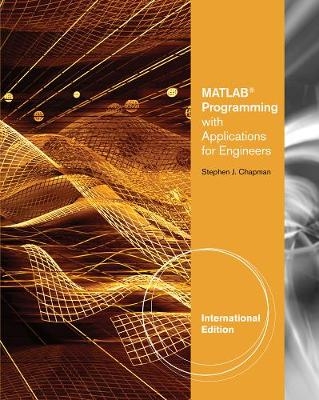
MATLAB Programming with Applications for Engineers, International Edition
CL Engineering (Verlag)
978-0-495-66808-4 (ISBN)
- Keine Verlagsinformationen verfügbar
- Artikel merken
Stephen J. Chapman received a B.S. in Electrical Engineering from Louisiana State University and an M.S.E. in Electrical Engineering from the University of Central Florida. He pursued further graduate studies at Rice University. Mr. Chapman has served as an officer in the U.S. Navy, assigned to teach Electrical Engineering at the U.S. Naval Nuclear Power School in Orlando, Florida. He was also affiliated with the University of Houston, where he ran the power systems program in the College of Technology. In addition, he has served as a member of the technical staff of the Massachusetts Institute of Technology’s Lincoln Laboratory, both at the main facility in Lexington, Massachusetts, and at the field site on Kwajalein Atoll in the Republic of the Marshall Islands. While there, he did research in radar signal processing systems. He ultimately became the leader of four large operational range instrumentation radars at the Kwajalein field site (TRADEX, ALTAIR, ALCOR, and MMW). Mr. Chapman also served as a research engineer at Shell Development Company in Houston, Texas, where he conducted seismic signal processing research. In addition, he was affiliated with the University of Houston, where he continued to teach on a part-time basis. Mr. Chapman is currently Manager of Systems Modeling and Operational Analysis for BAE Systems Australia in Melbourne, Australia. He is the subject matter expert of a team that has developed a model of how naval ships defend themselves. This model contains more than 400,000 lines of MATLAB code written over more than a decade. Mr. Chapman is a Senior Member of the Institute of Electrical and Electronic Engineers (and several of its component societies). He is also a member of the Institution of Engineers (Australia). Stephen J. Chapman received a B.S. in Electrical Engineering from Louisiana State University and an M.S.E. in Electrical Engineering from the University of Central Florida. He pursued further graduate studies at Rice University. Mr. Chapman has served as an officer in the U.S. Navy, assigned to teach Electrical Engineering at the U.S. Naval Nuclear Power School in Orlando, Florida. He was also affiliated with the University of Houston, where he ran the power systems program in the College of Technology. In addition, he has served as a member of the technical staff of the Massachusetts Institute of Technology’s Lincoln Laboratory, both at the main facility in Lexington, Massachusetts, and at the field site on Kwajalein Atoll in the Republic of the Marshall Islands. While there, he did research in radar signal processing systems. He ultimately became the leader of four large operational range instrumentation radars at the Kwajalein field site (TRADEX, ALTAIR, ALCOR, and MMW). Mr. Chapman also served as a research engineer at Shell Development Company in Houston, Texas, where he conducted seismic signal processing research. In addition, he was affiliated with the University of Houston, where he continued to teach on a part-time basis. Mr. Chapman is currently Manager of Systems Modeling and Operational Analysis for BAE Systems Australia in Melbourne, Australia. He is the subject matter expert of a team that has developed a model of how naval ships defend themselves. This model contains more than 400,000 lines of MATLAB code written over more than a decade. Mr. Chapman is a Senior Member of the Institute of Electrical and Electronic Engineers (and several of its component societies). He is also a member of the Institution of Engineers (Australia).
1. INTRODUCTION TO MATLAB.
The Advantages of MATLAB. Disadvantages of MATLAB. The MATLAB Environment. Using MATLAB as a Calculator.
2. MATLAB BASICS.
Variables and Arrays. Creating and Initializing Variables in MATLAB. Multidimensional Arrays. Subarrays. Special Values. Displaying Output Data. Data Files. Scalar and Array Operations. Hierarchy of Operations. Built-in MATLAB Functions. Introduction to Plotting. Examples. MATLAB Applications: Vector Mathematics. MATLAB Applications: Matrix Operations and Simultaneous Equations. Debugging MATLAB Programs.
3. TWO-DIMENSIONAL PLOTS.
Additional Plotting Features for Two-Dimensional Plots. Polar Plots. Annotating and Saving Plots. Additional Types of Two-Dimensional Plots. Using the plot function with Two-Dimensional Arrays.
4. BRANCHING STATEMENTS AND PROGRAM DESIGN.
Introduction to Top-Down Design Techniques. Use of Pseudocode. Relational and Logic Operators. Branches. More on Debugging MATLAB Programs. MATLAB Applications: Roots of Polynomials.
5. LOOPS AND VECTORIZATION.
The while Loop. The for Loop. Logical Arrays and Vectorization. The MATLAB Profiler. Additional Examples. The textread Function. MATLAB Applications: Statistical Functions. MATLAB Applications: Curve Fitting and Interpolation.
6. BASIC USER-DEFINED FUNCTIONS.
Introduction to MATLAB Functions. Variable Passing in MATLAB: The Pass-By-Value Scheme. Optional Arguments. Sharing Data Using Global Memory. Preserving Data Between Calls to a Function. MATLAB Applications: Sorting Functions. MATLAB Applications: Random Number Functions.
7. ADVANCED FEATURES OF USER-DEFINED FUNCTIONS.
Function Functions. Subfunctions and Private Functions. Function Handles. Anonymous Functions. Recursive Functions. Plotting Functions. Histograms.
8. COMPLEX NUMBERS AND 3D PLOTS.
Complex Data. Multidimensional Arrays. Three-Dimensional Plots.
9. CELL ARRAYS, STRUCTURES, AND IMPORTING DATA.
Cell Arrays. Structure Arrays. Importing Data into MATLAB.
10. HANDLE GRAPHICS AND ANIMATION.
Handle Graphics. Position and Units. Printer Positions. Default and Factory Properties. Graphics Object Properties. Animations and Movies.
11 MORE MATLAB APPLICATIONS.
Solving Systems of Simultaneous Equations. Differences and Numerical Differentiation. Numerical Integration--Finding the Area Under a Curve. Differential Equations.
APPENDIX A. ASCII CHARACTER SET.
APPENDIX B. ADDITIONAL MATLAB INPUT / OUTPUT FUNCTIONS.
MATLAB File Processing. File Opening and Closing. Binary I/O Functions. Formatted I/O Functions. The textscan Function.
APPENDIX C. WORKING WITH CHARACTER STRINGS.
String Functions.
APPENDIX D. ANSWERS TO QUIZZES.
| Erscheint lt. Verlag | 1.1.2012 |
|---|---|
| Sprache | englisch |
| Maße | 190 x 235 mm |
| Gewicht | 880 g |
| Themenwelt | Mathematik / Informatik ► Mathematik ► Computerprogramme / Computeralgebra |
| Technik | |
| ISBN-10 | 0-495-66808-7 / 0495668087 |
| ISBN-13 | 978-0-495-66808-4 / 9780495668084 |
| Zustand | Neuware |
| Informationen gemäß Produktsicherheitsverordnung (GPSR) | |
| Haben Sie eine Frage zum Produkt? |
aus dem Bereich


